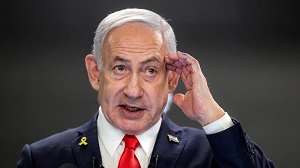As Asian, African powers offer mediation in Ukraine war, Western war makers reject peacemaking - By Michael Jansen, The Jordan Times
While UN and relief agencies and partisan groups dispute fatalities in the wider region's recent wars, the Costs of War Project at the Watson Institute at Brown University in the US has released a report which gives a comprehensive assessment of direct and indirect deaths from wars involving Washington since Al Qaeda attacked the US in September 2001.
The 39-page survey, "How Death Outlives War: The Reverberating Impact of the Post-9/11 Wars on Health," authored by the university's project director Stephanie Savell, reveals that more than 937,000 people have been killed directly in wars in Afghanistan, Pakistan, Syria, Iraq and Yemen while 3-6-3.7 million have died indirectly in these warzones, making a total of "at least 4.5-4.6 million and counting". More than 387,000 civilians have been killed while 38 million have become refugees or internally displaced persons. US costs have been $8 trillion. (This writer finds that the total population of these five countries reached 262 million at the time their citizens became caught up in unending warfare dubbed the "war on terror".)
The report focuses on the "devastating toll of war on human health, whoever the combatant, whatever the compounding factor, in the most violent conflicts in which the US government has been engaged in the name of counterterrorism" since September 2001. The report emphasises the fact that women and children bear the "brunt" of "long- term and underacknowledged consequences of war for human health."
The report also states that "indirect deaths grow over time" and gives the example of Afghanistan where the US-Taliban war began in 2001 and ended in August 2021. However, "Afghans are [now] suffering and dying from war-related causes at higher rates than ever." The case of Jalil Ahmad is cited. His mother says he is two and a half years old, but he looks a lot younger, as he is "severely malnourished and has tuberculosis".
He is one of millions of Afghan children" who have suffered from the indirect fall-out from the US war in their country. They die of infectious diseases (cholera and measles), cancer, food insecurity, malnutrition, injuries, trauma, inter-personal violence, destruction of infrastructure and public services, loss of employment and "deterioration of economic, social, psychological and health conditions". The author writes, "Indirect deaths are devastating, not least because so many of them could be prevented, were it not for war." Higher rates of death are recorded among people "who suffer from social injustices due to their poverty, gender, race, ethnicity and/or colonial legacies".
Body counts during and after wars are difficult to carry out, preventing fair assessments of the human costs of specific conflicts and engendering partisan accounts. The US war on Iraq is cited as the British medical journal The Lancet estimated that some 600,000 Iraqis had died "due to war violence between 2003-2006". The Lancet was accused of having a political agenda while critics were charged with the same offense. A 2008 study put the number of deaths at 151,000 while the Iraq Body Count, which counted combatant and civilian deaths, gave a figure of 300,000 violent fatalities. (The Pentagon kept track of the deaths of its soldiers and contractors but not of Iraqis, who were clearly considered non-persons not to be counted).
While deaths are lower in well developed countries, fatalities are higher in poor, developing countries or countries which had suffered long-term unrest, instability, drought, and degradation. (While the report suggests that Iraq's indirect deaths were reduced because the country had a reasonably developed health care system and infrastructure when the US attacked, Iraq had been seriously weakened by the 1991 war and more than a decade of sanctions.) Iraq was, however, more resilient than Yemen. The UN Development Programme reported in 2021 that 377,000 had died in war on Yemen, the poorest country in this region, 60 per cent of fatalities being caused by lack of access to healthcare, food, and water. In Yemen's case the ratio of four indirect deaths to one direct death seems to apply while in other cases the ratio could be three to one or two to one.
The author writes, "The report’s goal is to build greater awareness of the fuller human costs of these wars and support calls for the United States and other governments to alleviate the ongoing losses and suffering of millions in current and former warzones."
The Ukraine war has demonstrated that this goal cannot be achieved at the present time as leaders on all sides are determined to carry on whatever the costs to the Ukrainian people, countries which have welcomed Ukrainian refugees, and governments which have provided Ukraine with the expensive weaponry and political support to continue the war.
Ukraine's armed forces have sustained 124,500 to 131,000 total casualties, including 15,500 to 17,500 killed in action and 109,000 to 113,500 wounded in action. The UN has reported 23,376 civilian casualties, 8,709 killed and 14,666 injured. The ratio of direct to indirect deaths from injuries and other factors is likely to be smaller than in developing countries as Ukraine had functioning health care system although it has suffered war damage.
Russia has sustained 189,500 to 223,000 casualties, including between 35,500 and 43,000 soldiers killed in action and between 154,000 and 180,000 troops injured, Business Insider reported on April 10th. Russia's health care system has been ranked lowest of 55 developed countries.
Like the unprovoked 2003 US war on Iraq, the Ukraine war is a "war of choice" which could have been averted if Kyiv had declared, "No NATO" and refused to join the alliance, a move Russia's President Vladimir Putin had long regarded as a casus belli. While Russia invaded Ukraine on February 24th, 2022, Putin was mightily provoked by NATO’s steady advance toward Russia's borders. The provocation was exploited by US President Joe Biden and ex-British prime minister Boris Johnson, who sought political gain, and NATO Secretary-General Jens Stoltenberg who wanted to rescue the alliance from irrelevance.
While the Western public has been largely taken in by the aggressive stances adopted by Western leaders backing Ukraine and the pro-Ukraine media blitz, the Arab World, Asian and African powers have not, prompting Saudi Arabia, China and others to offer mediation while Western war makers reject peace-making.
Latest News
-
 ‘Israel’ launches major military operation in Jenin
‘Israel’ launches major military operation in Jenin
-
 ‘Israel’ recognizes Somaliland as sovereign state
‘Israel’ recognizes Somaliland as sovereign state
-
 Deputising for King, interior minister attends midnight Christmas mass in Bethlehem
Deputising for King, interior minister attends midnight Christmas mass in Bethlehem
-
 King, Crown Prince extend their Christmas greetings, New Year wishes
King, Crown Prince extend their Christmas greetings, New Year wishes
-
 Prime minister extends Christmas, New Year greetings to Christian community
Prime minister extends Christmas, New Year greetings to Christian community